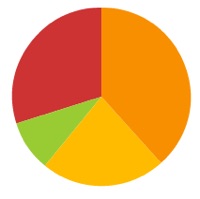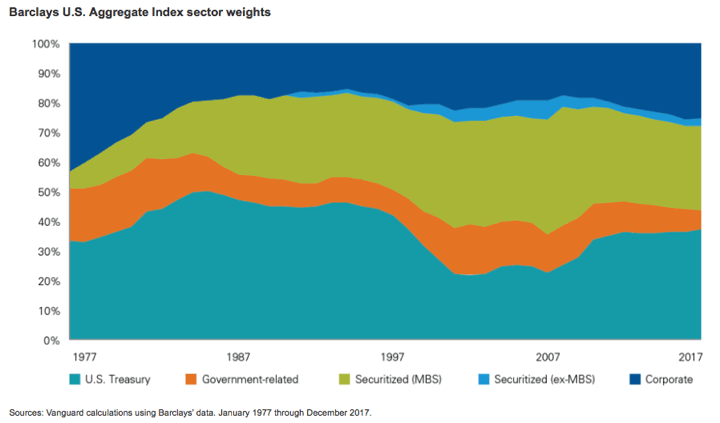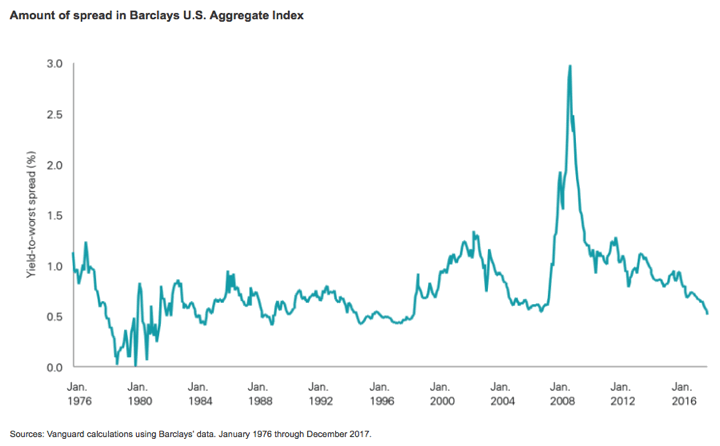 One of the major building blocks of your portfolio is probably a bond mutual fund or ETF. The most popular bond benchmark is the Bloomberg Barclays Aggregate Bond Index (AGG), which basically tracks all U.S. taxable investment-grade bonds. These popular index funds all track some variation of this index:
One of the major building blocks of your portfolio is probably a bond mutual fund or ETF. The most popular bond benchmark is the Bloomberg Barclays Aggregate Bond Index (AGG), which basically tracks all U.S. taxable investment-grade bonds. These popular index funds all track some variation of this index:
- Vanguard Total Bond Market Fund (VBTLX/VBMFX) and ETF (BND). The biggest bond mutual fund. This fund is also inside all Vanguard Target Retirement 20XX or LifeStrategy All-In-One funds.
- iShares Core U.S. Aggregate Bond ETF (AGG). The biggest bond ETF.
- Schwab U.S. Aggregate Bond ETF (SCHZ).
What’s inside a Total Bond fund? A recent Vanguard Blog post provides some insight into the components that make up the Barclays U.S. Aggregate Index from 1977 to 2017:

- US Treasury. Bonds issued and backed by the US government, including Treasury notes and bonds. (Nominal only, TIPS are not included.)
- US Government-related. Securities issued by a Federal Agency or a government-sponsored enterprise like Fannie Mae or Freddie Mac. These are either explicitly or implicitly backed by the US government.
- Securitized (MBS). Mortgage-backed securities, backed by residential mortgages and packaged by Ginnie Mae, Fannie Mae, Freddie Mac, and others including private issuers.
- Securitized (ex-MBS). Asset-backed Securities, backed by things such as consumer auto loans, credit card debt, and home equity loans.
- US Corporate. Securities issued by corporations with investment-grade ratings from the major ratings agencies.
The first thing to note is that the bottom three layers are essentially all backed by the US government. When considered in this chart format, you can see that these bottom three layers consistently make up about 60% to 80% of the AGG. Thus, historically you can estimate that roughly 2/3rds of the index is backed by the US government and 1/3rd is privately-backed by securitized assets or corporations.
How much more does a Total Bond fund yield than a Treasury Index fund? Here’s how much the AGG Total Bond index yields above a Treasury index historically:

So the ingredients are little riskier overall than 100% US Treasury bonds, but you also earn a little higher yield.
Which is better? For the most part, I agree with this William Bernstein list of what kinds of bonds should be in an individual portfolio. I slightly prefer either 100% Treasuries, municipal bonds, or bank CDs – all depending on the after-tax yield. The idea is to pick the safest bonds that are hopefully the least correlated with your stocks. For example, the expectation is that Treasuries are more likely to go up when stocks are dropping.
But for the most part, I think a total bond fund is just fine as well. You can see it’s still pretty safe and you get extra interest in exchange for the extra risk that the market has decided is the proper compensation.
First things first – Buying a low-cost total bond index fund is very likely to return more over the long run than an expensive actively-managed bond fund. Choosing between Treasuries and a Total Bond fund is a secondary decision.
Bottom line. Lots of people own bond funds and ETFs that track the US Aggregate Index (AGG). These charts help show you what’s held inside such Total US Bond funds and how much more they yield than 100% Treasury bonds.
 The Best Credit Card Bonus Offers – 2025
The Best Credit Card Bonus Offers – 2025 Big List of Free Stocks from Brokerage Apps
Big List of Free Stocks from Brokerage Apps Best Interest Rates on Cash - 2025
Best Interest Rates on Cash - 2025 Free Credit Scores x 3 + Free Credit Monitoring
Free Credit Scores x 3 + Free Credit Monitoring Best No Fee 0% APR Balance Transfer Offers
Best No Fee 0% APR Balance Transfer Offers Little-Known Cellular Data Plans That Can Save Big Money
Little-Known Cellular Data Plans That Can Save Big Money How To Haggle Your Cable or Direct TV Bill
How To Haggle Your Cable or Direct TV Bill Big List of Free Consumer Data Reports (Credit, Rent, Work)
Big List of Free Consumer Data Reports (Credit, Rent, Work)
I like EDV myself. All the safety of US Treasuries with the higher risk/reward profile. But that’s just my high risk tolerance showing. I say this even after the recent bond rout.
It is so easy right now to find high quality individual corporate bonds at par or less that are yielding something north of 4%. In addition, if you hold to maturity you get back all your principle and need not have any concern about fluctuations in bond prices or interest rates. So it leaves me somewhat mystified as to what the appeal of these funds are. Perhaps for 20 year+ bonds, thus allowing the fund to take on the duration risk. But the yield curve doesn’t say that long term makes economic sense right now or for the foreseeable future.
Check PONAX